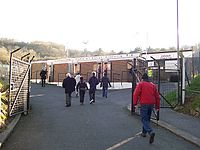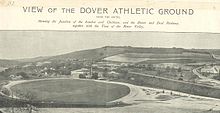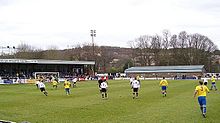- Crabble Athletic Ground
-
Crabble Athletic Ground 
The approach to the turnstilesFull name Crabble Athletic Ground Location  River, Kent
River, KentBuilt 1931 Opened 1931 Owner Dover District Council Operator Dover Athletic F.C. Surface Grass Capacity 6,500 (1,500 seats)[1] Field dimensions Unknown Tenants Dover United F.C. (1931–1933)
Dover F.C. (amateur club) (1934–1947)
Dover F.C. (semi-professional club) (1947–1983)
Dover Athletic F.C. (1983–present)
Margate F.C. (2002–2004)Crabble Athletic Ground (also known as The Crabble[2] or simply Crabble[3] and currently known under the terms of a sponsorship deal as The Perrys Crabble Stadium[4]) is a football stadium located in the northern Dover suburb of River, Kent, England. It was the home of the various incarnations of Dover F.C. from 1931 until the club folded in 1983. Since then it has been the home of Dover Athletic F.C., and it was also the temporary home of Margate F.C. between 2002 and 2004, when the club's Hartsdown Park stadium was being redeveloped. The stadium has two seated stands and two covered terraces and holds a total of 6,500 fans, although in the past, crowds larger than that figure could be accommodated. It also has a clubhouse, which the club completely redeveloped in 2008.
Contents
History
In 1896, a syndicate of local businessmen began a project to create a sports complex at the site known as Crabble Meadows on the outskirts of Dover. The word Crabble, which is also found in the name of a local corn mill,[5] derives from the Old English crabba hol, meaning a hole in which crabs are found.[6] The project was an extremely costly one but was completed in 1897,[7] and football was first played on the Crabble site in the same year.[8] In 1902, the original owners of the site, beset by financial problems, contemplated selling the land for redevelopment but eventually sold the site to the town council for £5,500.[7] The pitch was shared by the town's cricket and football teams, with the cricketers being given priority, which meant that the football team was forced to begin and end its season either with a long run of consecutive away matches or by playing matches at other, less satisfactory, venues in the town. To resolve the issue, the council opted to lay out a new football pitch further up the hillside, behind the lower pitch's pavilion. The first match played on the "upper pitch" took place in September 1931, with a small stand being constructed the following year. The football club then used the upper pitch whenever the lower pitch was unavailable due to cricket commitments.[9]
Dover F.C. applied for permission to build a grandstand on the southern side of the "upper pitch" in 1947, but the application was rejected. Three years later, the club was permitted to extend the existing small stand on the opposite side and in 1951, Dover F.C. moved to the upper pitch on a permanent basis, initially paying the council rent of £300 a year.[8] The final match on the lower pitch took place on 26 March 1951, and the first on the upper pitch was held eleven days later, when Fulham were Dover's opponents in a friendly. Due to a shortage of bolts, the grandstand had not actually been completed at this time.[1] Covered terracing at the Town End, where fans had previously stood on the hillside, was added soon afterwards.[8] Floodlights were added in 1961 and inaugurated with a match against a Chelsea XI.[1]
Dover F.C folded in 1983, but the newly-formed Dover Athletic took over the ground and continued to make improvements. When the team won the Southern League championship in 1990, however, promotion to the Football Conference was refused on the grounds that the stadium did not meet the standard required by the higher division.[10] Subsequently, new turnstiles were installed and two new terraces were built behind the goals. The seating in the main stand was replaced and a second grandstand was added on the opposite side of the pitch. These improvements meant that the club was able to gain promotion after its second Southern League title in 1993.[8] In the 2002–03 and 2003–04 seasons, Margate F.C. played home fixtures at the stadium while redevelopment work took place at their own Hartsdown Park ground.[11] What was originally intended to be a short-term arrangement ended up lasting for two years as the redevelopment work stalled.[12][13]
Between 2003 and 2004, the ground was known as the Hoverspeed Stadium under the terms of a sponsorship deal.[14] In 2007, the club announced that under another such arrangement, the stadium would be known as the SeaFrance Crabble Stadium, however a year later it was announced that the deal would not be renewed due to the ferry operator's financial constraints.[15][16] On 1 July 2008, the club announced local car dealership Perry's as the club's new main sponsor, with the stadium being rebranded as the Perry's Crabble Stadium.[4] In 2008 the club launched a project to replace the existing clubhouse with a new £200,000 building featuring a larger bar, better audio-visual facilities and a high quality kitchen. The club hopes the new building will become a popular venue for social and business functions.[17]
Other uses
The lower pitch at Crabble was used by Kent County Cricket Club as one of its home venues for first-class cricket matches from 1907 to 1976, a total of 106 first-class matches being played there.[18]
Structure and facilities
 A plan of the ground
A plan of the ground
The stadium is known for its unusual location, being set into the side of a hill. It has two seated stands and two covered terraces. The Main Stand, which has been in place since 1951, occupies the length of one side of the pitch and has a roof supported by numerous columns, which obscure the view for some fans. Identical covered terraces for standing spectators are behind both goals, which also suffer from an obstructed view. The small Family Stand occupies a portion of the side opposite the Main Stand. The remainder of this side of the ground is taken up by the clubhouse, toilets and other club facilities. Unlike most football stadiums, the club directors' lounge is set atop one of the stands.[8] In December 2009 the Football Association gave the stadium's facilities an A grade, meaning that it meets the minimum standard for entry to the Football League.[19]
The stadium is approximately 1.5 miles (2 km) from Kearsney railway station, which lies on Southeastern's Chatham Main Line from London Victoria to Dover Priory.[20] Dover Priory itself is further away, but connecting bus services are available.[8] Parking is available around the perimeter of the adjacent rugby club.[21]
Records
The highest attendance ever recorded at the ground was recorded when "just under 7,000" fans were in attendance for a match between Dover F.C. and Folkestone on 13 October 1951.[1] Current club Dover Athletic's highest ever home attendance was 4,186 for the visit of Oxford United in the first round proper of the FA Cup on 16 November 2002.[22]
References
- ^ a b c d Stuart Croll (2007-09-25). "Ground of the Week : The Crabble Stadium". BBC. http://www.bbc.co.uk/london/content/articles/2007/09/24/nl_dover_feature.shtml. Retrieved 2008-02-02.
- ^ "Dover 1-1 Morecambe". BBC. 2002-04-20. http://news.bbc.co.uk/sport1/hi/football/eng_conf/1935692.stm. Retrieved 2008-04-14. "The hosts, already relegated, showed plenty of spirit and enjoyed the majority of possession in an entertaining encounter at The Crabble."
- ^ "Visiting Crabble". Dover Athletic F.C.. http://doverathletic.com/index.php?p=crabble. Retrieved 2008-04-14.
- ^ a b "Whites in the fast lane". Dover Athletic F.C.. 2008-07-01. http://doverathletic.com/index.php?p=news&id=1125. Retrieved 2008-07-02.
- ^ "Crabble Corn Mill". Crabble Corn Mill Trust. http://www.ccmt.org.uk/. Retrieved 2008-02-04.
- ^ "The Origin of Dover's Name". Dover-Kent.co.uk. http://www.dover-kent.co.uk/history/name_origin.htm. Retrieved 2008-02-02.
- ^ a b "Crabble Athletic Ground, Dover, England". CricInfo (reprinted from Playfair Cricket Monthly, 1965). http://content-usa.cricinfo.com/england/content/ground/56957.html. Retrieved 2008-04-14.
- ^ a b c d e f "Dover Athletic F.C.". Pyramid Passion. http://www.pyramidpassion.co.uk/html/dover_athletic.html. Retrieved 2008-04-14.
- ^ "The Grounds". The History of Dover Football Club. http://talesftre.tripod.com/doverfootballclub/id7.html. Retrieved 2008-04-14.
- ^ Bateson, Bill; Albert Sewell (1990). News of the World Football Annual 1990/91. Invincible Press. pp. p122. ISBN 0-8854-3207-1.
- ^ "Club 'could fold' over stadium". BBC Sport. 2003-10-15. http://news.bbc.co.uk/1/hi/england/kent/3195602.stm. Retrieved 2008-04-14.
- ^ "Plans for stadium 'insufficient'". BBC Sport. 2004-12-30. http://news.bbc.co.uk/1/hi/england/kent/4136349.stm. Retrieved 2008-04-17.
- ^ "New hope for football stadium". BBC Sport. 2004-02-08. http://news.bbc.co.uk/1/hi/england/kent/3470641.stm. Retrieved 2008-04-17.
- ^ "New sponsorship deal for Dover brings new ground name". Non League Daily. 2003-07-05. http://www.nonleaguedaily.com/news/index.php?newsmode=FULL&nid=10104. Retrieved 2008-02-14.
- ^ Matthew Clements (2007-01-08). "SeaFrance on board". Dover Athletic F.C.. http://www.doverathletic.com/index.php?p=news&id=836&link=/. Retrieved 2008-04-14.
- ^ "Sponsor cutback hits Whites". Dover Athletic F.C.. 2008-05-27. http://www.doverathletic.com/index.php?p=news&id=1105. Retrieved 2008-06-05.
- ^ Justin Allen (2007-11-03). "Centre Spot 2008". Dover Athletic F.C.. http://www.doverathletic.com/index.php?p=news&id=937. Retrieved 2008-04-14.
- ^ "First-class matches played at Crabble Athletic Ground, Dover (106)". CricketArchive. http://www.cricketarchive.com/Archive/Grounds/11/455_f.html. Retrieved 27 June 2010.
- ^ "Whites make the A grade". Dover Athletic F.C.. 22 December 2009. http://www.doverathletic.com/index.php?p=news&id=1424. Retrieved 22 December 2009.
- ^ "Live Departures: Kearsney (KSN)". National Rail Enquiries. http://www.livedepartureboards.co.uk/ldb/summary.aspx?T=KSN. Retrieved 2008-04-15.
- ^ "Dover Athletic". Association of Wheelchair & Ambulant Disabled Supporters. http://www.awads.co.uk/index.php?command=db&page=Dover%20Athletic. Retrieved 2008-04-15.
- ^ Williams, Tony; Mike Williams (2007). Non-League Club Directory 2007. Tony Williams Publications Ltd. p. p515. ISBN 1-8698-3355-4.
External links
Kent County Cricket Club Kent County Cricket Club · Kent Women · Seasons · Tunbridge Wells Cricket Week Players Grounds Current grounds Previous grounds Beckenham (Foxgrove Road) · Blackheath · Catford · Chatham · Dartford · Dover · Folkestone · Gillingham · Gravesend · Maidstone · Margate · Tonbridge · Town MallingCaptains List of Kent County Cricket Club first-class captains · List of Kent County Cricket Club List A captains · List of Kent County Cricket Club Twenty20 captainsRecords Seasons 1906 · 1909 · 1910 · 1913 · 1967 · 1970 · 1972 · 1973 · 1974 · 1976 · 1977 · 1978 · 1995 · 2001 · 2005 · 2007 · 2009Coordinates: 51°08′16.13″N 1°17′05.58″E / 51.1378139°N 1.2848833°E
Categories:- Defunct cricket venues in England
- Football venues in England
- Buildings and structures in Kent
- Dover Athletic F.C.
- Margate F.C.
- Cricket grounds in Kent
Wikimedia Foundation. 2010.



